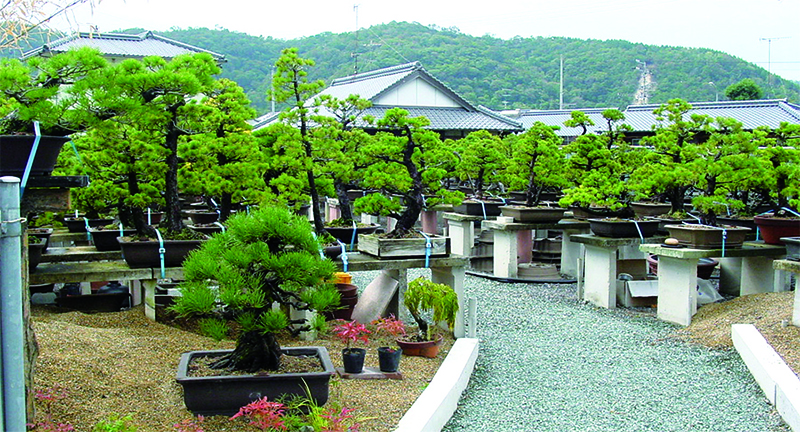
1-1. What is “Akaishi Goyomatsu”?

Akaishi five-needle pine grows naturally around the Akaishi Mountains centering on Mt. Higashi Akaishi (1706m) in Doi-cho, Shikokuchuo City, Ehime. The pine tree has been around the mining areas since the ancient times and it is designated as a natural monument of Ehime Prefecture.
The pine grows naturally around in the magnificent nature
The steep slopes of the Akaishi Mountains formed a huge primeval forest filled with the native Japanese pine, as well as other plants such as cypress, northern Japanese hemlock, and enkianthus perulatus, etc. The tens of thousands of pine trees have a history of hundreds of years and they have all essential bonsai elements- versatile shapes, twisting patterns, turns, and curves.
They have been known and cherished by bonsai lovers since the Tokugawa period. From the slight cracks over the towering cliffs, they extend to cling along, withstand the cold wind and snows but still remain sublime and elegant.
1-2. Classic bonsai with discernible shapes and features

For its tiny leaves and splendid form, “Akaishi Bonsai” is also named “Himekomatsu” (literally “little princess pine”). Generally, pines are two-needled but Akaishi has five. It’s native to Japan and big ones could reach 30 meters high.
It is strong and it presents various tailoring patterns; the trunk skin is rough and glum. With excellent sprouting and as mentioned, the color of the leaves is sharp with notable silver linings.
It is strong and it presents various tailoring patterns; the trunk skin is rough and glum. With excellent sprouting and as mentioned, the color of the leaves is sharp with notable silver linings.
Among bonsai lovers there is a saying goes, “start bonsai with five-needle pine and complete also with five-needle pine”. It is, all in all, the signature of bonsai.
If black pine, another representative species, is known as the dignified “king of bonsai”, five-needle pine should be called “queen of bonsai” for its splendid postures.
1-3. As the queen of bonsai

According to “Kojiki” ("Records of Ancient Matters", composed by Ono Yasumaro in 712), th birth of goddesses Izanagi and Izanami created Japan as a country as in local myth, they were “Ehime of the Iyo Province”, which means “goddesses of the province”.
Hence, “Ehime” refers to lovely and gorgeous princesses. It is the origin of the name of Ehime prefecture, the only prefecture in Japan named after mythical goddesses.
Five-needle pine is called “Himekomatsu” in Japanese, with the region of origin “Ehime” in it. The name itself means a soft and supple female. The name “Akaishi bonsai” thus embraces its origin, the prefecture, and the appearance of the plant- it deserves to be the “queen of bonsai”.
1-4. Preservation of the original species

Akaishi bonsai is historical and originated from primeval forest.
Mount Akaishi has been well preserved by local vigilantes who watched around every day and night since around 1955 when there were overlogging and logging problems.
And now, all members of Akaishi bonsai union still work hard to inculcate the utmost quality “Akaishi five-needle pine” based on traditions and past experience.
Bonsai is an expression of the magnificent nature and flow of time. It is also a projection of the trees in nature and the view it forms. It is like a model-size figure of nature.
Akaishi bonsai is the reduced form of the primeval forest in Mount Akaishi. The appearance is delicate and soft while the central stem is strong to show the forest protected by the local community. Everything is presented on a small tray. Such a tasteful scene might only be found on this “queen of bonsai, Akaishi five-needle pine” indeed.






















